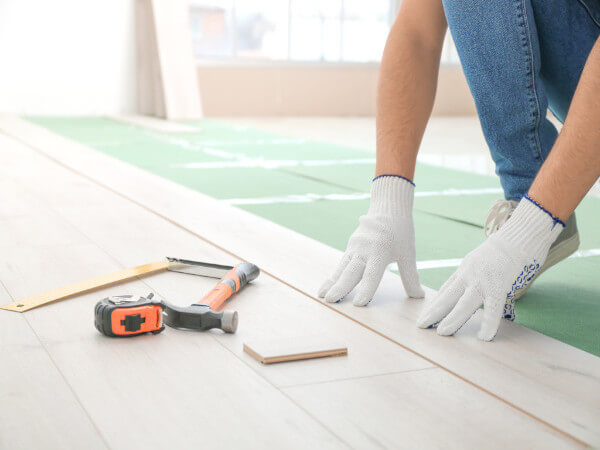
The art of feng shui has been practiced for more than 3,000 years. Its principles of creating balance and harmony within the home have become more relevant and desirable in today’s ever-moving, fast-paced world. With purposeful furniture placement and incorporation of natural materials, it can be an effective approach to cultivating a peaceful and relaxing home environment. However, structuring your living space to reflect a feng shui design requires more thought and precision than one might think.
Feng shui offers benefits beyond a tidy living room. While the term “feng shui” is used by designers and real estate agents alike, the ancient practice holds a very specific purpose and meaning. With the tips in this guide, you can manipulate the energy in your home to promote health, passion, success and an overall better quality of life. Learn how to create the ultimatefeng shui interior designfor every room in your home.
What Is Feng Shui?
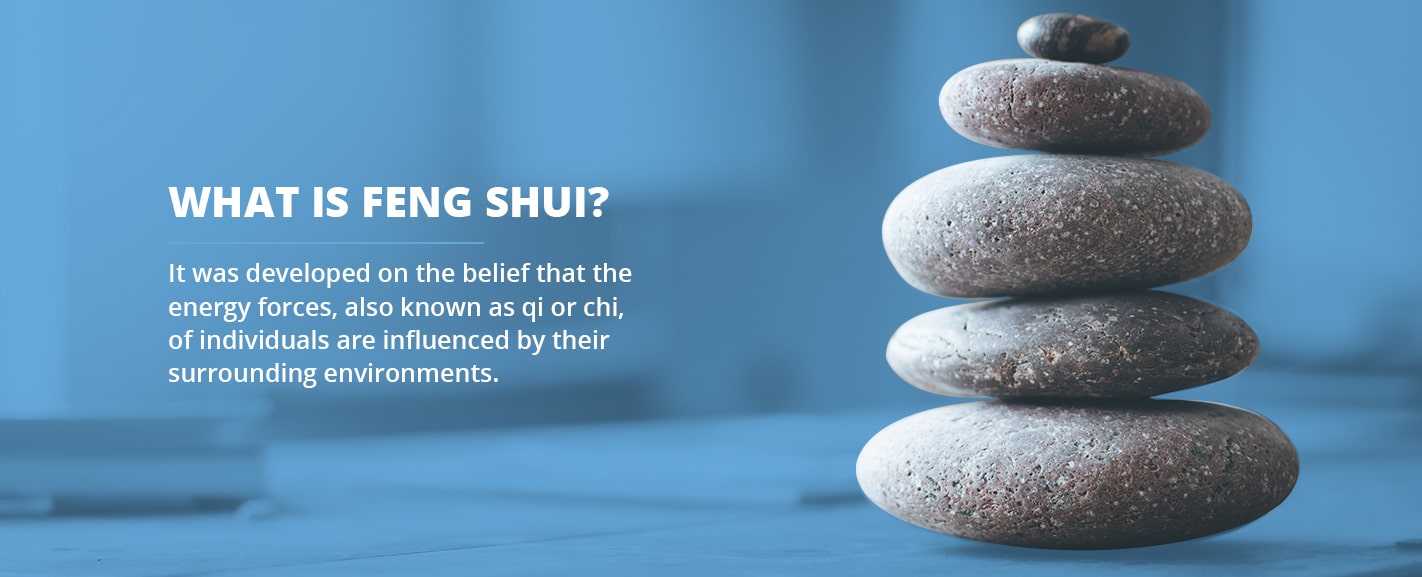
Feng shui is a practice that originated in ancient China. It was developed on the belief that the energy forces, also known as qi or chi, of individuals are influenced by their surrounding environments. The phrase “feng shui” translates to “wind water.” More specifically, feng shui aims to block the wind and cache the water. Water is believed to bring good fortune and wealth.
Planning the layout and design of your home according to feng shui allows positive energy to flow uninhibited through your house and bring you success and prosperity.
The Elements of Feng Shui
Like other design methods, feng shui comes with its own set of rules to follow. These guidelines help promote an effortless flow of qi throughout your house while organizing your living space to reflect a calm and harmonious environment.
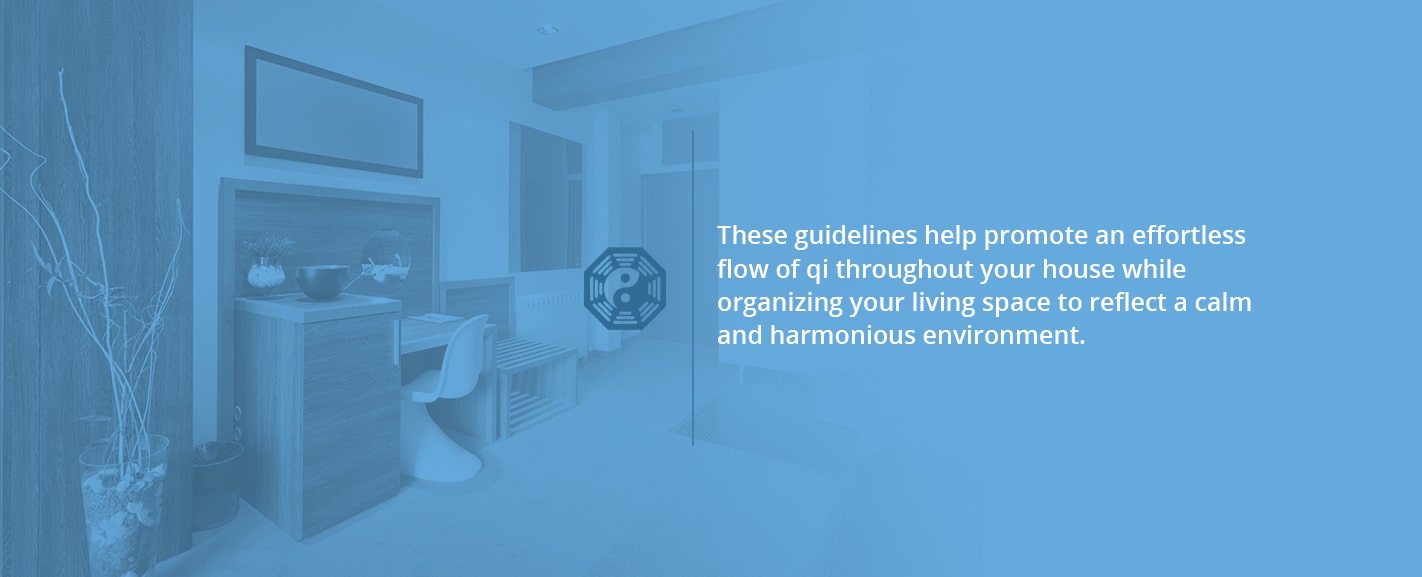
Qi, pronounced “chee,” is a transient negative or positive energy that lives within every individual and space. In ancient China, feng shui was practiced by rural communities in the placement of local gravesites to harness the energy of deceased ancestors and other life forces. With this practice, farmers and villagers expected to receive an abundance of prosperity.
The goal is to find the perfect location for each piece of furniture in your space. Keep in mind that though this guide outlines the universal components of feng shui design, the end result will differ from person to person. From where to place your bed to the color of your floors, the layout of each room in your house will determine how your space will look at the end of its makeover.
There are several variations of feng shui practices, but these are key commonalities that will transform your home:
The Five Elements
Feng shui principles begin with the five elements earth, fire, water, metal and wood. In both literal, symbolic and metaphysical ways, these elements regulate different areas within your home. They govern the shapes, colors and emotions that correspond with specific areas featured on the bagua map
Here is how the five elements play a role in interior design:
EarthThose who are familiar with chakras and yoga know that the earth symbolizes balance and stability. Earth is seen as a primarily feminine element that strengthens the emotions of feeling grounded and centered. You can easily incorporate this element at home by furnishing your rooms with crystals or salt lamps, clay vases and candle holders, landscape art and earth-colored flooring and carpets that feature gold or red tones.FireFire represents passion, emotional expression and energy. It fans the flames of inspiration, popularity and transformation. Adding candles and pops of bold reds and vibrant oranges with fresh flowers, throw pillows and art will energize any room. Refrain from using these colors in rooms where you want to relax, as they can be very stimulating.Water There’s a reason the sound of flowing water and rain showers is so relaxing — water symbolizes wisdom, clarity and serenity. The element of water is believed to promote wisdom and help us connect with others. You can use cool or dark colors to bring this element into your home — a mocha- or gray-colored wood floor can perfectly encapsulate water traits. If you’re not a fan of blue tones, adding reflective surfaces and mirrors will have the same effect without imposing on your personal style.
MetalThis element may have you scratching your head, wondering how you can casually incorporate metallic elements into your decor. However, metal is a more dynamic element than you may think. While many people consider metal to be cold and strong, it also represents logic, knowledge, beauty and self-assurance. As a flexible energy, you can embrace this element by adding decor that is gray and white, or using smaller accent pieces like bookends or sculptures.WoodWood represents healing, flexibility, growth and progress. It is associated with masculine traits, but can be adaptive to feminine energy because it is also related to new life. While wood is perhaps one of the easiest elements to include in your home decor, too much of it will throw your home’s energy off balance. So, instead of going overboard with wood paneling, try adding healthy green plants and furnishings that are green, blue and teal.
The Bagua Map

The most efficient and common tool for understanding feng shui design is the bagua map. “Bagua” translates to “eight areas,” and is displayed as a three-by-three grid of nine boxes. Each of these squares correlates with a different area of your life, also known as “life aspirations.” These include wisdom, wealth, love, health, family, fame, helpful people, children and career. Other variations of the bagua map are linked to the four directions and astronomy. Every category is connected to an element and color.
The purpose of the bagua map is to analyze the energy within a space and determine what elements are still needed in order to enhance the natural flow of energy. If there are areas in your home that need improvement, you can reference the five elements to bring balance and strength. This is how the elements and bagua categories correlate to one another:
Earth: Health, love and wisdomFire: FameWater: CareerMetal: Children and helpful peopleWood: Wealth and family
The easiest way to use a bagua map to feng shui a house is to lay it over your floor plan with the doorway facing south, and see where the nine energies fall within your home. However, since every house is different, the best way to follow the bagua map is to draw a rough outline of your home’s floor plan. Then, divide the drawing into nine proportionate squares, like a tic-tac-toe board, and label the squares according to the categories displayed in the bagua map.
How to Feng Shui: Where to Begin

Once you understand the basic principles of feng shui, you’re ready to start redecorating. Knowing your elements and mapping out your home are only the first steps in harnessing positive energy and creating an uplifting and relaxing space. These guidelines will break down the fundamental rules of feng shui so you can start feeling more grounded and at peace today.
1. Declutter and Clean
While some may argue that messiness is a sign of genius, most would agree clutter and excess causes chaos and confusion. A clean space can do wonders for your mental state and leaves more open spaces for incoming energy. If you haven’t given your home a good cleaning or purged your closets and storage of things you no longer use or need, this will give you the motivation to get it done. Don’t forget to maximize your natural light by cleaning your windows!
2. Address Your Entryway
The entryway of the home is called the “mouth of qi.” This is where energy enters into your living space and what people see from the outside. Therefore, it represents your face to the rest of the world. It is important to keep the entry of your home clean and clutter-free. This will allow qi to flow freely. Keeping your entryway clean doesn’t mean it should be completely empty. Rather, focus on making it as warm and welcoming as possible.
3. Consider the Command Position
The commanding position is one of the most commonly practiced feng shui principles. The concept of the command position is believed to help you take charge of your life while feeling secure within the space. In order to achieve this, your bed, desk and stove should be placed in positions that allow you to easily view anyone coming through the door of the room. This doesn’t just keep your subconscious at ease, it also makes you more aware and open to new opportunities that are coming your way.
The command position for each piece of furniture will be different in every room, based on the placement of the door. Feng shui dictates that the ideal position for the best energy flow is the furthest diagonal point from the door. This placement is particularly important in rooms where you spend the most amount of time.
If you aren’t able to place your main pieces of furniture in this location, position them so you can see the door from wherever you are sitting, laying or standing. This is a crucial rule when arranging your bedroom. You are at your most vulnerable when you’re sleeping at night. If you can’t see the door from where you’re lying down, you may feel tense and anxious the exact opposite of how you want to feel when you’re going to sleep.
4. Eliminate Obstacles
Feng shui is all about efficiency, in one form or another. There should always be a wide, clear path from room to room, as well as enough space for you to move freely throughout each room. Remove any tripping hazards and similar obstacles that inhibit movement. This may mean it’s time to move that coffee table you keep bumping into.
5. Use Color
Color can instantly liven up a space or send it into a spiral of confusion. We’ve reviewed the relationship between colors and the five elements, so you know how important it is to create and maintain a balance of energy in your home using the appropriate colors. In order to achieve this, you will have to take it one room at a time.
The absence or excess of one element or another can quickly throw your space off balance. To fix this, start by surveying the room and noting what tones stand out the most. If you are missing characteristics of a specific element, it should be obvious. For example, if your carpet and walls feature earth tones with metal picture frames or wall decor, you’ll notice that water and wood elements are missing. In this case, you may feel a surge of energy and awareness when you enter the space, making it difficult to relax.
If you’re in touch with your emotions, you can use your feelings and various aspects of your life to guide your inclusion of new colors. If you have been experiencing mental fog and indecision, then grays, whites and metallic tones correlating with the element of metal can provide clarity and precision. For a rush of energy and wisdom, turn to water-related colors like black and dark blue. The five elements are balanced within nature, and colors are one way to bring that stability into your own life.
Feng Shui Interior Design Ideas
The ancient concept of feng shui is widely accepted and practiced in Western design for its inherent comfort and aesthetic. While the original intent of feng shui was to encourage positive energy flow and growth and prosperity in every aspect of life, there’s no denying the physical appeal of this particular design strategy.
These interior design ideas will inspire you with new and creative ways to integrate feng shui elements into your home:
1. Balance the Living Room
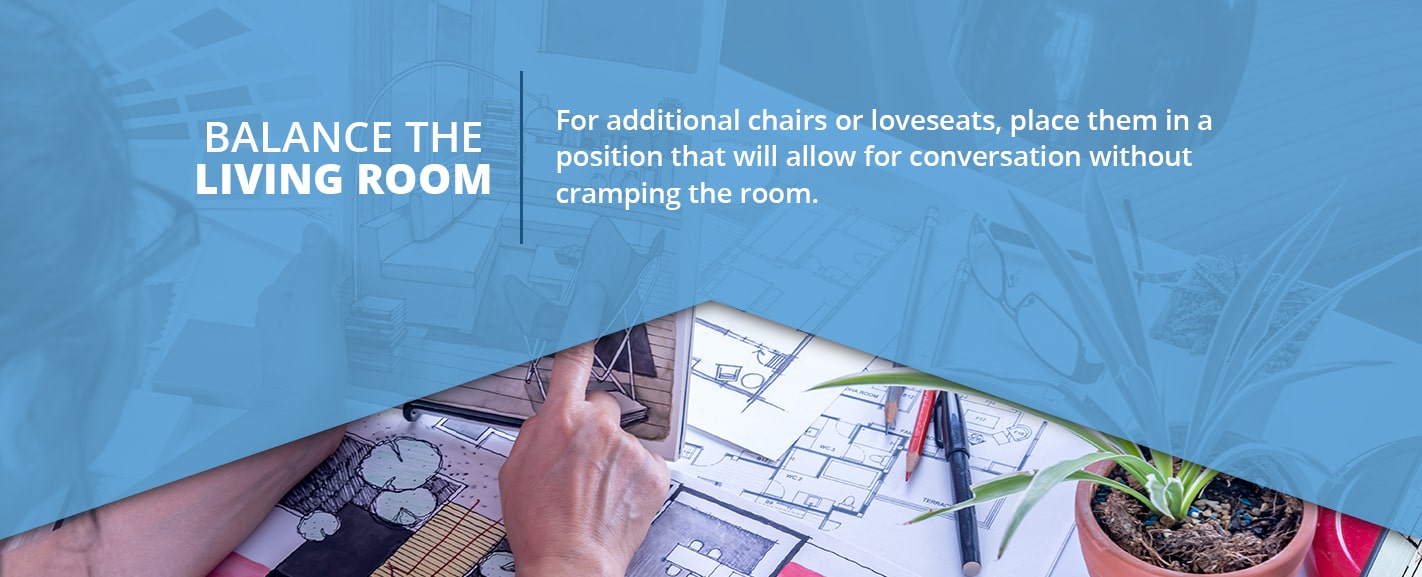
The living room is known as a family space and a gathering place for friends and visitors. It houses the largest pieces of furniture, which can quickly make the room feel cluttered and dark. To rearrange the space to reflect feng shui’s design principles, start by moving the sofa so it faces a door and is backed against a wall, preferably the wall that is furthest from the door. There should be a few inches of space between the couch and the wall.
For additional chairs or loveseats, place them in a position that will allow for conversation without cramping the room. When choosing a coffee table, it’s best to buy one that doesn’t have sharp angles. However, if a round shape contrasts too much with the rest of your furniture and decor, you can use a supplement with circular shapes in other areas, like pillows and mirrors.
2. Craft a Calm Bedroom
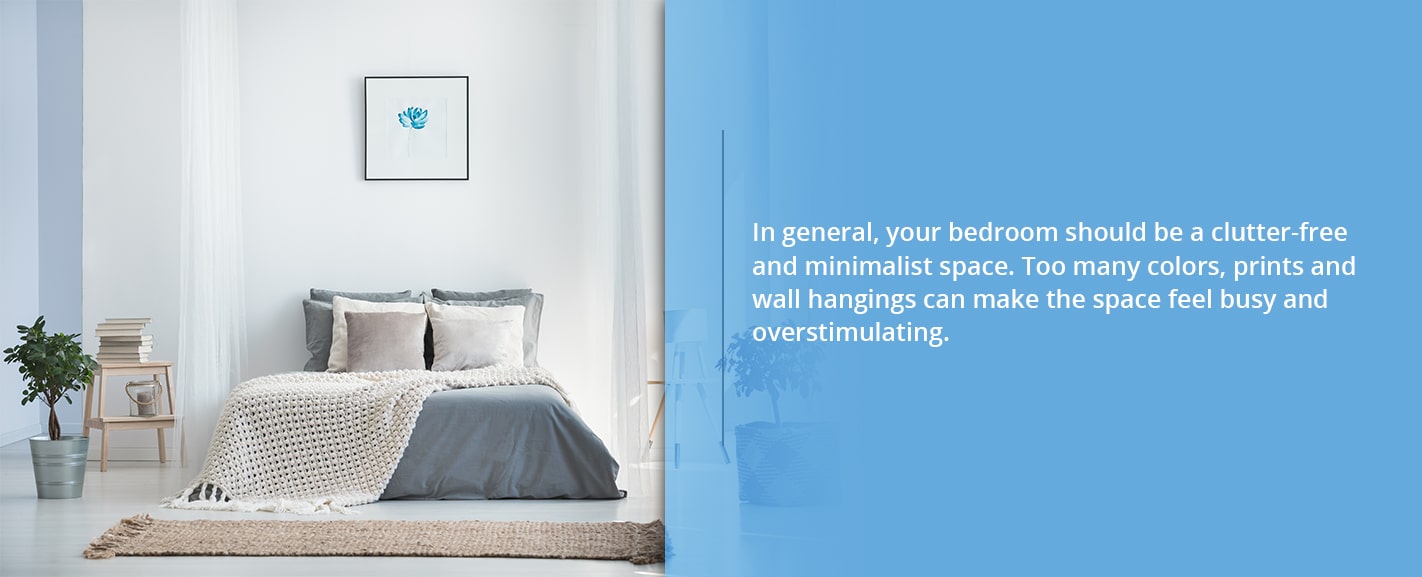
In general, your bedroom should be a clutter-free and minimalist space. Too many colors, prints and wall hangings can make the space feel busy and overstimulating. To create a calm and peaceful bedroom, place your bed away from the door, but not in the direct path of the door.
Remove electrical components that sit next to your bed, such as phone chargers and remote controls. While keeping your cellphone close by is a hard habit to break, having it on hand at all times drains your creative energy and affects your focus and clarity. To create balance and tranquility, avoid putting a television in your bedroom. Bedroom TVs can take away your positive and peaceful energy, and they also become the focal point of the space, which is distracting and unattractive.
Abedroom should have elements of masculine and feminine energy. An example of equal balance and representation is using a metal bed frame and covering your mattress with soft-colored blankets and linens. Remember that each element offers its own energy. So if you feel like something is missing from your bedroom, take inventory of the elements that are already represented and fill in the blanks.
Lastly, optimizing your storage may be what is causing your energy to turn for the worst. When your house or apartment lacks closet space, one of the first solutions you think of is to use the empty space under your bed. However, feng shui principles suggest doing the opposite. Filling the space under your bed inhibits qi from flowing freely throughout the space. Rather than adjusting the living space to meet your abundance of material possessions, consider scaling back for a more minimalist approach.
3. Think Floor to Ceiling
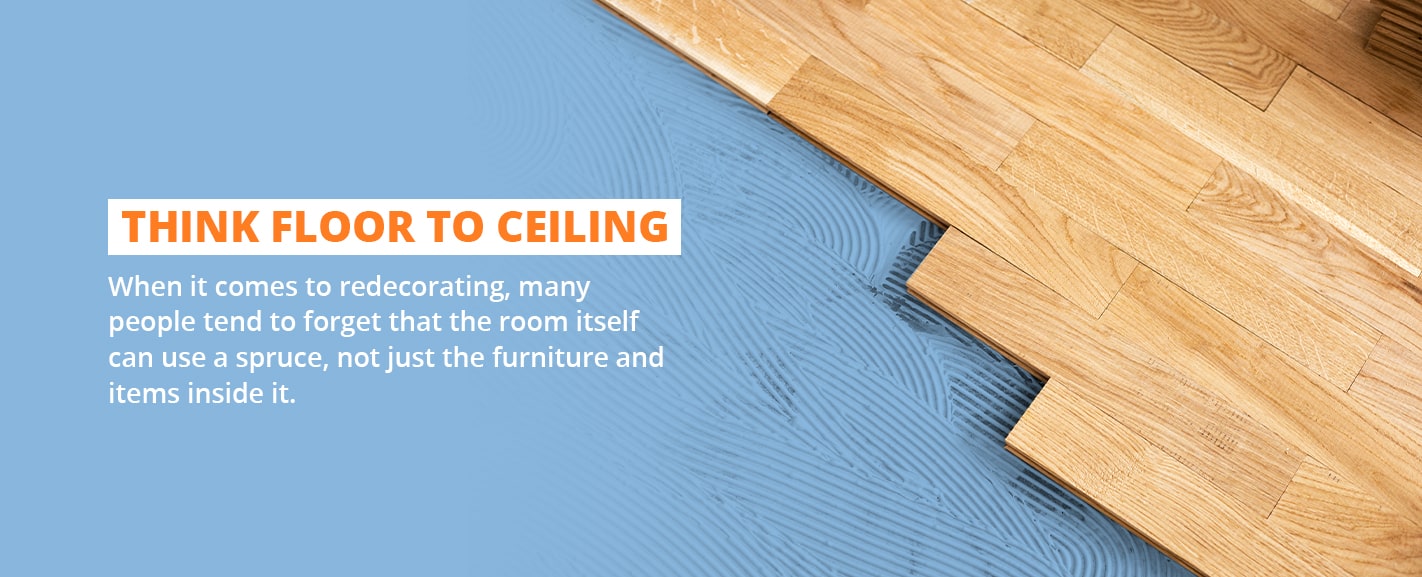
When it comes to redecorating, many people tend to forget that the room itself can use a spruce, not just the furniture and items inside it. Your floors are the foundation for cultivating the perfect feng shui design in your home.
Changing the type of wood, laminate or carpet in your house will make a significant difference in the overall appearance and energy within the space. Keep in mind, flooring for feng shui also involves keeping your floors clean. A clean home naturally makes your space feel brighter and more welcoming.
The corners of a room can also fall victim to neglect. However, they are just as important as any other element of design. The state of corners in a room is a telltale sign of how clean you keep your house, though they are often left untouched when spring cleaning comes around. Remember to dust the corners and vents of every room as you rearrange them.
Lastly, you may be hanging your wall decor too low or off-center. If you have been experiencing depression or dips in your energy, take a look at how your art and picture frames are placed and readjust if necessary.
4. Remove Signs of Negativity
To complete this list offeng shui tips, it’s absolutely vital that you remove any negative symbolism that occupies your space. We subconsciously absorb everything that fills our surroundingenvironment. From movies and television shows to traffic patterns and outside noise, we are affected by everything around us. Negative energy gets into our space unintentionally through symbolism.
Your home is a place of comfort and intimacy, and allowing negativity inside can perpetuate challenges and fear. Remove any bleak or gloomy pictures, dead plants and furniture with severe angles.
If you feel a drop in your mood or confidence when entering a space, this means there may be unaddressed negative feelings associated with something in the room or the room itself. Be sure to note any changes in your own qi as you survey each room in your house, especially if you are particularly affected by a certain object or location within the room. This is a major sign that it’s time to change things up and rebalance your space.
Contact 50 Floor to Get Started With Feng Shui Flooring
50 Floor offers the ultimate at-home shopping experience for homeowners looking to create a positive and uplifting space. As experts in our craft, we bring all our flooring options to your door, so you can see how every color and material works with your personal decor and style. For more than four decades, we have solidified our reputation as the experts in flooring, with hundreds of samples to choose from.
Browse our flooring trend guidefor more inspiration. If you’re ready to transform your home, schedule a one-on-one consultationtoday!

The post A Guide to Feng Shui Interior Design appeared first on 50 Floor.